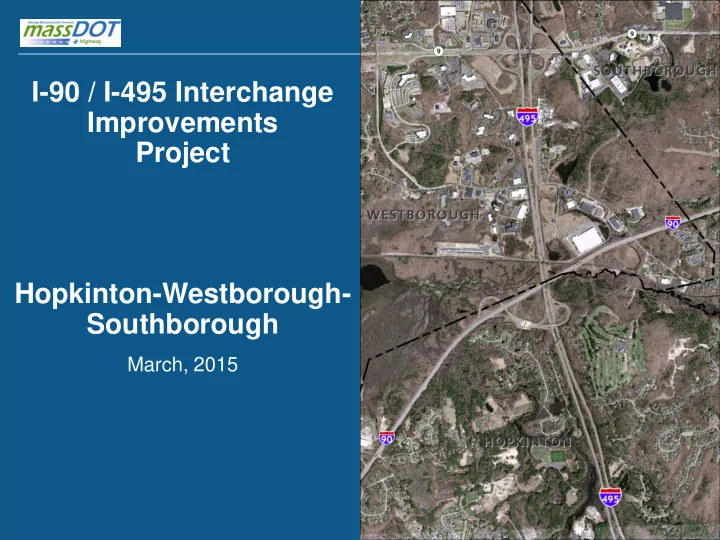

I-90 / I-495 Interchange Improvements Project Hopkinton-Westborough- Southborough March, 2015
MEPA Scoping Session − Page Czepiga, EEA, MEPA Unit − Renata Welch, P.E., MassDOT Highway Division − Dave Derrig, AECOM
MEPA Process Overview • MEPA requires state agencies study the environmental consequences of their actions, including permitting and financial assistance. • Requires all feasible measures to avoid, minimize, and mitigate damage to the environment. • Requires that state agencies minimize damage to the environment by studying alternatives to the proposed project. • MEPA review is not a permitting process. MEPA requires public study, disclosure, and development of feasible mitigation.
When is MEPA review required? • Project requires a State Agency Action: ─ Proposed by a State Agency ─ State Permit ─ Financial Assistance ─ Land Transfer • Project meets or exceeds a MEPA review threshold: ─ Land, Rare Species, Wetlands, Water, Wastewater, Transportation, Energy, Air, Solid/Hazardous Waste, Historical/Archaeological Resources ─ MassDOT projects typically exceed thresholds associated with Land, Wetlands and Transportation
MEPA Applicability • The project is being undertaken by a state agency, requires a permit from a state agency and may receive state funding • MEPA jurisdiction is broad in scope (not limited to one area of environmental impact) • Triggered EIR Review Thresholds: ─ Land: Creation of >10 acres of impervious area ─ Wetlands : Alteration of >1 acre of Bordering Vegetated Wetlands; requires a Variance from Wetland Protection Act
MEPA Process Schedule • ENF Filed with MEPA: 2/27/15 • Environmental Monitor Notice: 3/11/15 • MEPA Consultation Session: 3/19/15 (today’s meeting) • Comments Due: 3/31/15 • Secretary’s Certificate Issued: 4/10/15
Background • Historic congestion at interchange associated with toll plazas • MassDOT planning study (2012-2013) identifying deficiencies and need for improvements • Implementation of All Electronic Toll System (AETS) July 15, 2016 • MassDOT Feasibility Study (2014) to identify options to improve safety and mobility - ENF filed March 2, 2015 • Elimination of toll plazas will not eliminate congestion and safety issues
Safety and Operational Issues • Substandard geometry • Magnitude of passenger vehicle traffic • Magnitude of truck traffic • Vehicle conflicts (weaving sections) within interchange area • Crash history at ramps and through interchange
What Are We Trying to Do • Eliminate Weaving Movement Conflicts • Improve Interstate-to-Interstate Design • Reduce Congestion and Travel Time • Minimize Resource Impacts
Concept Development & Screening • “Blank Slate” configurations • Modifications maintaining appropriate design speeds and geometry • No design exceptions • Eight original concepts • Over 20 additional variations • Three advanced to ENF stage (Concept 22-3, Concept 14-5, Concept 14-4)
Concept 22-3
Concept 14-5
Concept 14-4
Preliminary Traffic Modeling • Based upon 2035 Priority Development Areas scenario • Baseline (No Build) represents conditions with toll plazas removed • Weekday AM and PM peak hours analyzed • All three concepts provide acceptable operations and address weaving and congestion concerns
Future PM Peak Hour Conditions (2035) – No Build Insert video clip 2035 No Build PM
Future PM Peak Hour Conditions (2035) – Concept 14-4
Preliminary Resource Impacts
Conceptual Cost Estimates • Concept 22-3 $285,000,000* • Concept 14-5 $220,000,000* • Concept 14-4 $165,000,000* note: does not include engineering, mitigation or ROW costs * 2014 Dollars
Overall Project Schedule 1 Planning Study 2 Feasibility Study/ Conceptual Design 3 EA / EIR / 25% Design 4 Final Design and Permitting 5 Early Action Construction 6 Construction Complete Current Stage
Next Steps • Continue to refine concepts and impacts calculations • Work with MPOs (Boston, Central Mass) to include project in long-range plans • Procure consultant services for environmental documentation / 25% / permitting • Prepare Environmental Assessment / Environmental Impact Report for NEPA and MEPA and obtain permits • Design and Construction
Public Comment Comments on the proposed project must be submitted by March 31, 2015 in writing via hard copy, email, or fax to: 1. Secretary Matthew Beaton Executive Office of Energy and Environmental Affairs Attn: MEPA Office, Page Czepiga 100 Cambridge Street, Suite 900 Boston, MA 02114 2. Email comments to: Page.Czepiga@state.ma.us 3. Fax#: (617) 626-1181
Recommend
More recommend